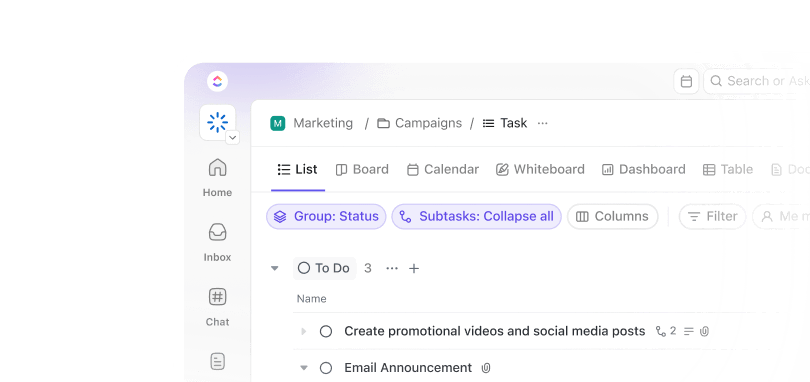

Before instant messages, Zoom calls, and digital dashboards, the seeds of virtual project management were planted during NASA’s Project Apollo.
Engineers and scientists spread across different locations coordinated with astronauts in space—without the luxury of modern tech. If they could achieve moon landings with primitive communication systems, imagine what you can do with today’s tools!
The opportunities are endless. If you’re a virtual project manager looking to uplevel your processes or planning to switch to virtual project management from the traditional setup, this article is for you.
We’ll share actionable strategies to manage a virtual team effectively, essential virtual project management tools you must have in your tech stack, and ways to handle critical challenges.
⏰ 60-Second Summary
How to master virtual project management for remote teams:
- Define goals and break down work: Set clear objectives and break virtual projects into manageable tasks
- Choose the right tech stack: Use a mix of tools for communication (ClickUp Chat, Slack, Zoom), file sharing (Dropbox), time tracking (Toggl), or get everything you need on one platform for project management with ClickUp
- Establish communication guidelines: Schedule regular meetings, set response times on different channels, and embrace async communication with project management tools
- Create a collaborative environment: Use ClickUp to assign tasks, set deadlines, and keep everyone on the same page. Kanban boards, List Views, and Docs help visualize projects and foster teamwork
- Help your virtual project team work smarter: Free up time for creative tasks by automating repetitive processes with ClickUp Automations
- Prioritize mental health: Promote work-life balance with clear boundaries and mental health resources
- Track progress and review performance: Use tools like Gantt charts or Kanban boards to visualize progress
- Encourage a positive team culture: Recognize achievements, celebrate milestones, and organize virtual team-building activities to boost morale and connection
What Is Virtual Project Management?
Virtual project management is the process of leading a project where the team operates remotely and uses digital tools to collaborate, communicate, and track progress.
Why is virtual project management important?
Virtual project management helps you go beyond the confines of traditional office spaces. The arrangement makes it possible to build hybrid or remote teams and manage projects effortlessly despite not being under the same roof.
Switching to virtual project management will also allow you to care for your team’s well-being. A McKinsey survey reveals that, when given an opportunity, 87% of Americans choose to work in a flexible setup.
With virtual work, your team can stay productive while still spending quality time off with their families.
Also Read: The 7 Key Benefits of Virtual Teams
Key differences from traditional project management
Here’s how virtual project management differs from conventional project management:
| Factors | Virtual project management | Traditional project management |
| Team location | Teams are geographically dispersed, working remotely | Teams are in the same office or location |
| Communication | Relies on virtual project management tools | Primarily in-person meetings or phone calls |
| Timings | Flexible hours and locations, often in different time zones | Fixed working hours and office attendance required |
| Collaboration | Online collaboration platforms for real-time teamwork | Face-to-face collaboration in office spaces |
| Cost-efficiency | Can reduce costs related to travel and office space | Higher costs due to physical office space rent, travel costs, and in-person meetings |
👀 Did You Know? A remote.co survey shows that 63% of respondents would ‘absolutely’ look for a new job if they could not continue working remotely.
Benefits of Virtual Project Management
Let’s go over the advantages of virtual or remote project management:
🌍 Access to an international talent pool
Virtual project management breaks down geographical barriers so you can hire the best talent regardless of location and improve the quality of work.
🏁 Greater autonomy
With no commute and more control over their time, remote employees enjoy flexibility. Autonomy boosts motivation and productivity and keeps your team engaged. In fact, according to McKinsey’s survey, 83% of American employees say they can work more efficiently and productively, which is a primary benefit of remote work.
💸 Cost savings (for both company and employees)
Companies can save on overhead costs like office space, utilities, and physical infrastructure. Your employees also benefit, as they can avoid relocating, eliminate daily commuting costs, and save time.
🔍 Establish transparent task management systems
Real-time updates, task assignments, and project timelines allow you to identify bottlenecks quickly before they become larger issues.s.
Since assigned tasks/deliverables are documented and easily accessible for review (through virtual project management tools), project managers can evaluate team members’ performances with more clarity and transparency.
Implementing Virtual Project Management
Let’s break down the essentials of managing virtual teams and projects. We’ll cover everything from setting clear goals to leveraging powerful tools to keep your team connected and productive.
1. Define goals and objectives
The first step is to clearly define the project’s aims, specific deliverables, and expected outcomes. You must ensure that everyone on the team understands the project’s purpose and vision.
💡Pro Tip: Try ClickUp’s SMART Goals Template to organize your goals and get a step closer to accomplishing things you’ve envisioned!
Once you’ve set the objectives, break down the project into manageable phases/milestones (or sprints if you’re using Agile methodology).
Assign tasks to team members, prioritize crucial tasks, and set deadlines to track the project’s progress and prevent delays easily.
ClickUp’s Project Management tool would be an excellent fit for your virtual team.
It allows you to create task lists, set priorities, assign team members, and track progress visually. You can also define specific deadlines, owners, and dependencies for each task and keep your workflow organized.

2. Choose your tech stack wisely
The entire virtual project management system runs based on digital tools.
Here are some essential virtual project management tools to have in your tech stack:
- Project management: Remote work tools such as ClickUp, Monday.com, and Jira offer robust task tracking, collaboration, and resource management
- Communication: Use Slack or Microsoft Teams for real-time messaging. Create channels for specific topics, teams, or project phases to organize discussions. Zoom or Google Meet comes in handy for video meetings
- File sharing: Use cloud storage solutions like Google Drive, Dropbox, or OneDrive to store and share documents securely
- Time tracking: Toggl or Harvest are great tools for tracking time spent on tasks. They help virtual project managers keep projects on budget, identify roadblocks, and understand how remote team members allocate their time
However, switching between multiple apps can be tedious. The easiest solution is to use remote work software like ClickUp. Thanks to its robust integrations, you can manage your entire tech stack from one place.
For example, ClickUp integrates with Slack and MS Teams; alternatively, you can use ClickUp’s native communication tools, like ClickUp Chat and ClickUp Clips, which bring video and text communication to your project management system (we’ll also get into the details shortly).
You can integrate ClickUp with Zoom, Toggl, Harvest, EvenHour, Google Drive, and Dropbox.
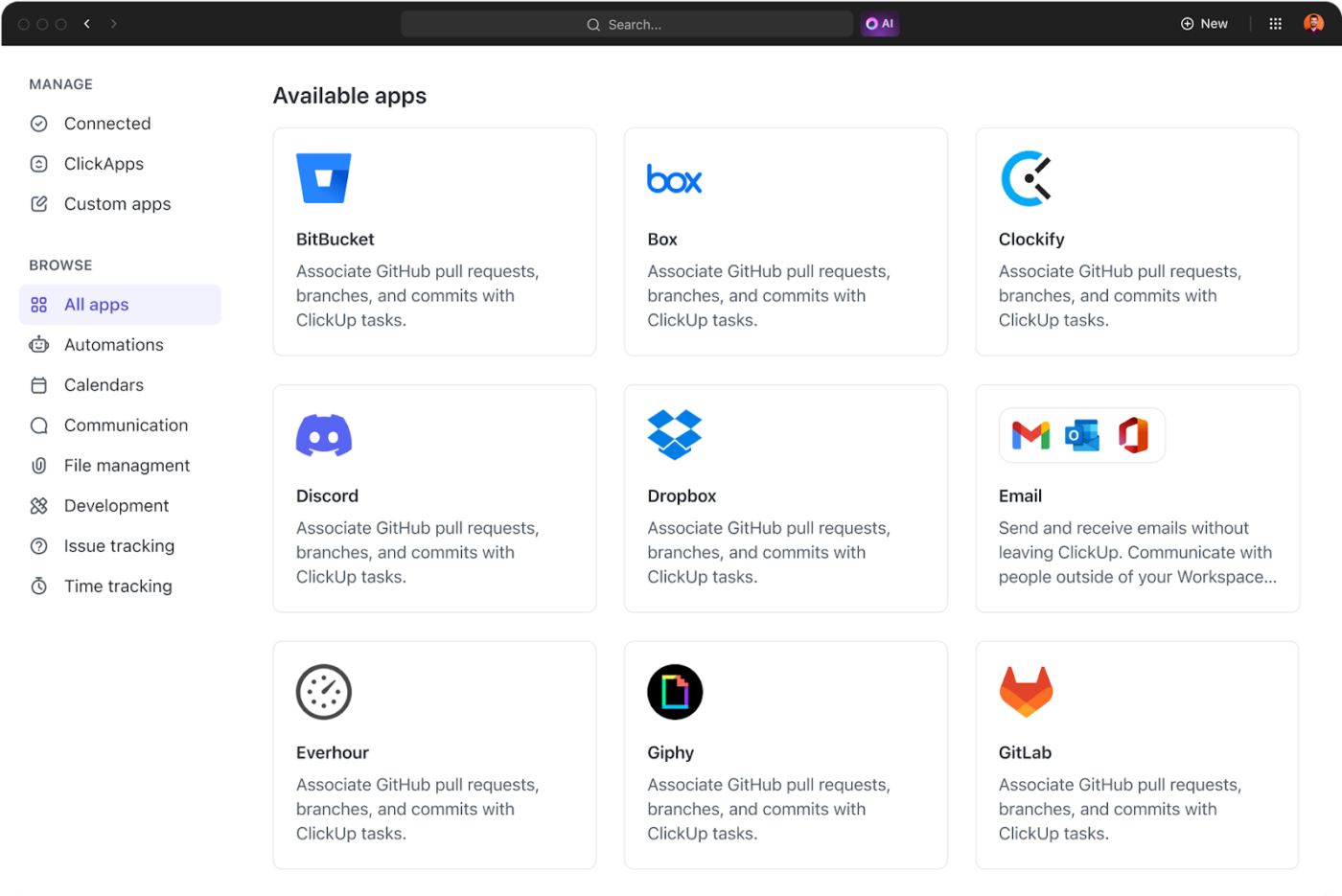
3. Establish communication guidelines
Clear communication is key to virtual project management.
Here’s how to structure it:
- Schedule regular meetings (e.g., daily stand-ups for quick updates or weekly reviews to track progress). Project managers can use meeting agenda templates to keep meetings focused and productive
- Set expectations for response times across different communication channels. For instance, Slack could have a one-hour response window, while email might be 24 hours
- Define when to use specific tools (e.g., ClickUp Chat/Slack for quick updates, email for formal communication, and Zoom for in-depth discussions)
When managing a distributed team, you must be mindful of time zone differences.
Try to schedule meetings during overlapping hours for teams in different time zones. Tools like World Time Buddy can help you find common working hours.
To maintain a smooth workflow for remote or virtual teams, embrace sync communication. Use project management tools to share updates, feedback, and progress reports that don’t require a real-time response.
ClickUp Chat
On ClickUp, work and chat are no longer siloed. ClickUp Chat unites the two and streamlines communication for your virtual team. From quick DMs to company-wide announcements, ClickUp Chat offers it all.

You can connect tasks directly to messages to ensure every conversation has context. With FollowUps, you can instantly turn comments into tasks and take action faster.
ClickUp Clips
Beyond real-time communication, you can champion async work with ClickUp Clips and task comments.
For example, ClickUp Clips lets you record your screen and communicate your message clearly without requiring you to hop on calls.

If you have to share/seek feedback or have a query regarding a task, you can tag a teammate using ClickUp’s task comments, and they’ll be notified.
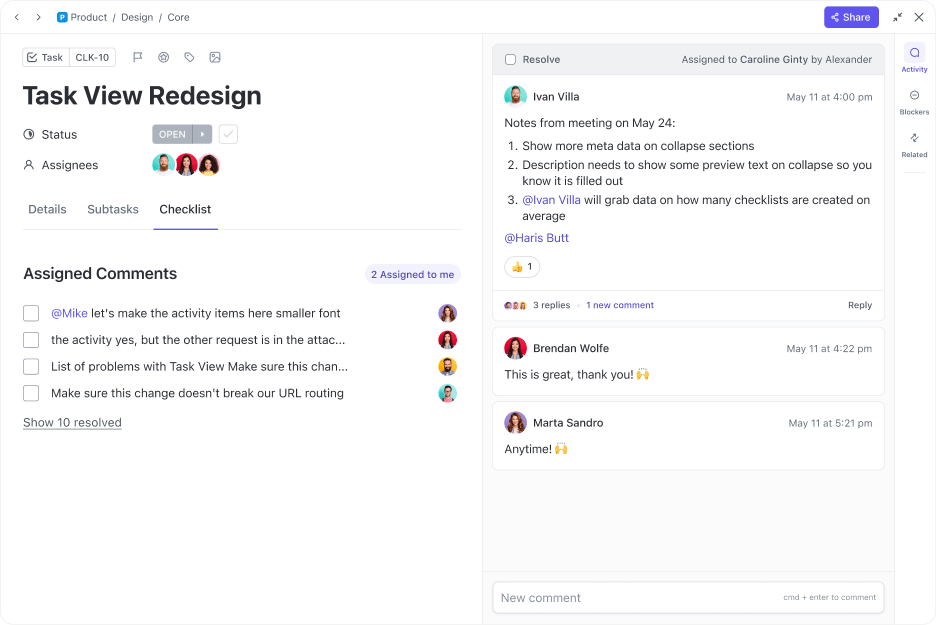
From customizable workflows and multiple communication channels to ready-to-use project management templates, multiple benefits make ClickUp unique.
4. Create a collaborative environment
Collaboration is much easier when teammates work under the same roof, and this is one of the biggest challenges of remote work.
Sure, the convenience of asking a colleague for help sitting beside you might be unmatched, but with the right tools in your toolkit, you can recreate a similar experience and collaborate in real time.
Here’s how you can encourage teamwork in remote settings:
- Use project management tools to assign tasks, set deadlines, and keep everyone on the same page regarding what’s being worked on and who’s responsible for what
- Incorporate tools in your workflow that allow teams to collaborate on projects in real time
- Encourage employees to share their feedback and take action to address the issues they’re facing
If you’re using ClickUp’s Remote Work platform, you’ll get access to a range of collaboration tools. Here’s how you can make the most of this software:
- Organize tasks in a simple, linear format with ClickUp’s List View and manage task priorities with filters and Custom Fields
- Visualize projects with a Kanban-style board using ClickUp’s Board View. Drag and drop tasks between stages to monitor progress in real-time
- Stay on top of deadlines by viewing tasks on a calendar with ClickUp’s Calendar View and make room for quick adjustments
- Capture task details through customizable forms using ClickUp’s Form View. Collect feedback from remote workers and automatically convert submissions into tasks

- Consolidate key metrics and project data into customizable, visual reports with ClickUp Dashboards to monitor performance and track project progress in real time
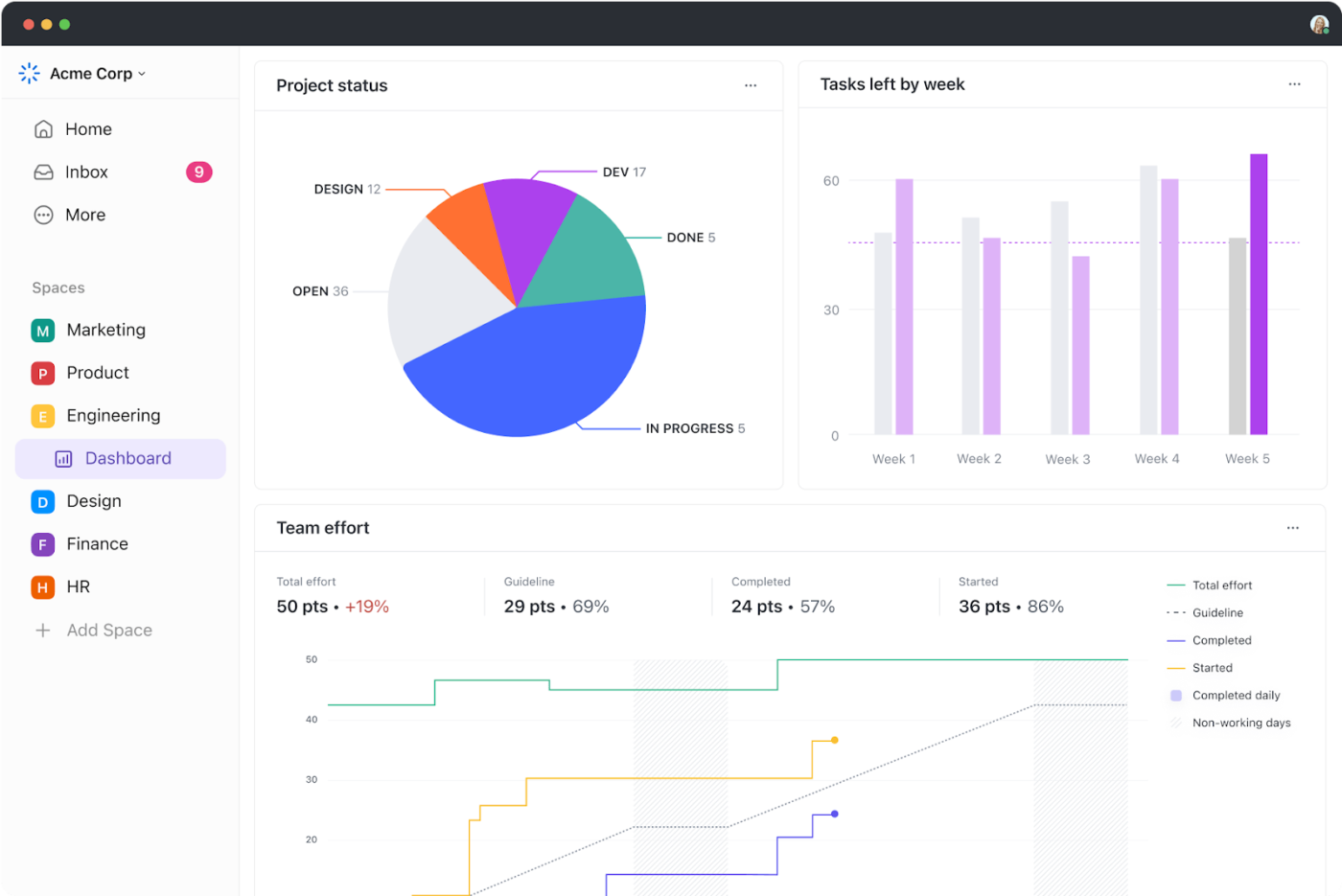
- Create, edit, and collaborate on documents directly with ClickUp Docs (ideal for meeting notes, project plans, or knowledge bases that stay linked to your tasks and workflows)
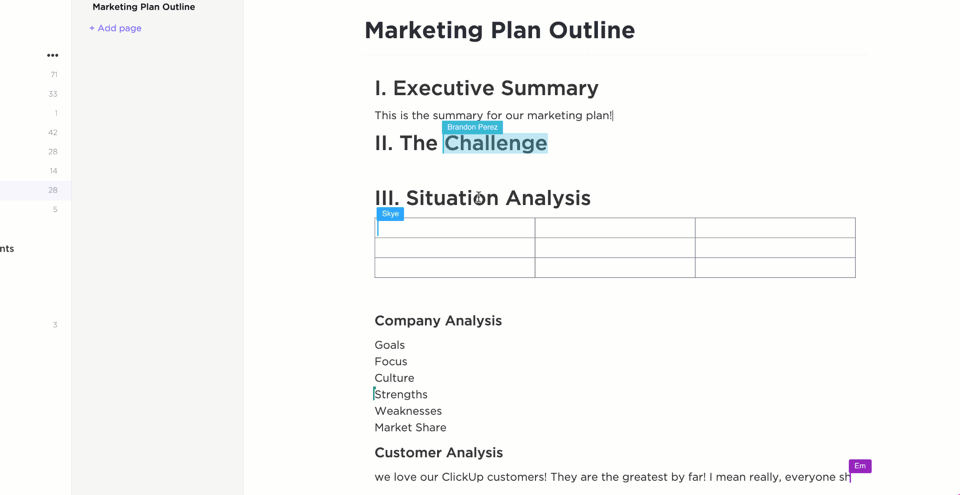
- Brainstorm, map out ideas, and collaborate visually with your virtual team members in real time on ClickUp Whiteboards, a virtual interactive canvas
5. Help your team work smarter
In virtual project management, face-to-face interactions are often minimal. Long hours of strenuous, tedious tasks can make the job feel like a chore rather than something your team enjoys. With tools to speed up work, team members can retain their creativity without feeling drained.
Free up your team’s schedule to focus on high-value, creative, or strategic work, and let the mundane tasks run on autopilot.
Educate and train your team on the latest AI tools and encourage them to implement them (following internal guidelines) in their daily workflow. For instance, on ClickUp, you can get help from the tool’s native AI assistant, ClickUp Brain. Use Brain to:
- Ask questions about tasks, Docs, and people within your workspace
- Get automatic project updates and status reports
- Craft messages in a desired tone, generate summaries from long texts, and edit documents for spelling errors
- Transcribe voice notes from ClickUp Clips into text
- Describe your task in plain English, and create workflow automation instantly for any Space, Folder, or List

With ClickUp Automations, you can trigger specific actions based on preset conditions. From changing task status/assignee/priority to responding to customer emails, you can automate multiple repetitive tasks and save time.
Best Practices for Virtual Project Management
Managing projects virtually requires clear team communication, consistent tracking, and keeping the team engaged. Let’s look at some best practices to make remote project management successful:
1. Assign roles and responsibilities
Make sure everyone knows exactly what they’re responsible for.
Use a tool like the RACI Matrix (Responsible, Accountable, Consulted, and Informed) for each task. Ensure that each person understands their tasks, deadlines, and expectations to keep the project moving forward smoothly.
2. Track progress and review performance
To track milestones and task dependencies visually, use tools like Gantt charts, Kanban boards, or project progress dashboards.
Regular check-ins (whether weekly or monthly) align the team and allow you to address roadblocks early. Effective progress tracking allows you to adjust your schedule or resources and maintain deadlines.
3. Maintain motivation and engagement
Recognize your virtual team’s small and big achievements and celebrate milestones to boost morale.
Incorporate virtual team-building activities, like online games or virtual happy hours, to strengthen connections, combat isolation, and recreate the fun of water cooler conversations to some extent.
You can also plan offsite retreats or team-building events (virtual or in-person) to strengthen relationships and reinforce team culture.
Strategies to Overcome Virtual Management Challenges
While virtual jobs have multiple perks for both the employer and the employee, you also have to address the downsides. According to Gallup’s research, exclusively remote employees feel least connected to their organization’s mission or purpose.
If your team feels disengaged, it can lower team morale, reduce productivity, and affect job satisfaction. This is a manager’s worst nightmare.
Here are some common challenges of virtual management that you must be aware of and a few actionable strategies to mitigate them.
Challenge 1: Onboarding and training
In virtual setups, new employees miss out on in-person interactions that help them understand the company culture and internal processes. As a result, remote onboarding feels impersonal and might even lead to gaps in knowledge.
✅ Solution:
- Create a structured onboarding plan: Develop a clear, step-by-step onboarding process with a series of virtual training modules/walkthroughs that introduce new hires to the company’s values, culture, tools, and workflows
- Set up a buddy system: Pair new hires with an experienced team member who can act as a mentor, answer queries, and provide emotional support. With this system, you can bridge the gap of physical distance and create a sense of connection within the team
- Develop a knowledge base: Invest time in pre-recording videos and creating a knowledge base with frequently asked questions and common workflows. These resources will allow new hires to self-serve when they need clarification on processes
- Frequent check-ins: Schedule regular check-ins with new employees during their first few weeks to ensure they’re not feeling lost. These check-ins can be in the form of 1:1 meetings, feedback sessions, or team-wide virtual meetups, where new hires can ask questions and receive guidance
Challenge 2: Tracking productivity without micromanaging
It’s difficult to gauge productivity when employees are working remotely. As a virtual project manager, you might be micromanaging your team (e.g., checking in on task progress too frequently) without even realizing it.
Micromanagement can result in frustration, hinder the autonomy of employees, and make them feel like you don’t trust them.
✅ Solution:
- Shift focus to results, not hours worked: Instead of focusing on the number of hours employees spend working, emphasize the tangible results, i.e., project deliverables
- Use project management software: Use a comprehensive virtual project management tool like ClickUp to keep your team organized without the need for constant check-ins.
- Provide autonomy with regular check-ins: Schedule weekly or bi-weekly one-on-ones to review progress, answer questions, and provide feedback. During these virtual meetings, focus on collaboration and problem-solving, not micromanagement
💡Pro Tip: Set goals using frameworks like OKRs (Objectives and Key Results) or KPIs (Key Performance Indicators) to tie individual contributions to a bigger outcome and track productivity efficiently.
Challenge 3: Employee burnout
Despite offering flexibility, remote work often blurs the lines between work and personal life. Long working hours can feel stressful, and they might struggle to switch off at the end of the day, leading to burnout.
✅ Solution:
- Encourage work-life boundaries: Promote the importance of setting clear boundaries between work and personal time. Encourage employees to use time-blocking methods to schedule their work hours and protect their personal time.
- Wellness programs or mental health days: Prioritize mental health by offering wellness programs, mental health resources, online counseling services, and mental health days. Create an open environment where employees feel comfortable discussing challenges
- Model healthy behavior: As a leader, your actions set the tone for the team. If you regularly work late or send emails after hours, your employees may feel compelled to do the same. Set a positive example by logging off at a reasonable hour and prioritizing personal time
💡Pro Tip: Have ‘no-meeting’ days or set aside specific hours during which employees are not expected to work (e.g., no emails after 7 PM) to help employees establish these boundaries
Say Yes to Seamless Virtual Collaboration with ClickUp
Whether you’re managing a software development team, marketing team, or a digital agency, powerful virtual project management software can make your business run much more smoothly.
And for remote teams, what can be a better option than ClickUp?
The platform unifies different types of project management tools, offers synchronous and asynchronous communication, lets you automate recurring processes, allows easy progress tracking, and more.
Make ClickUp your virtual HQ and move your projects to success—get started for free today!

